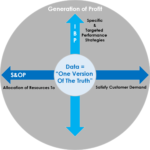Maximizing Your S&OP – IBP Profit Contributions
There is a lot of discussion in the market about Sales and Operations Planning (S&OP) and Integrated Business Planning (IBP). One line of thought is that companies with mature S&OP programs will naturally evolve to include enhanced IBP capabilities. I have a separate view and believe these two important business activities serve different but complimentary purposes. Regardless of where you are on this issue, the question is “How do I get the maximum value out of S&OP and IBP activities that will continue to positively impact the bottom line?”
What does that have to do with analytics and big data? Well just about everything. Regardless of how you are addressing your S&OP and IBP business requirements, they both require the support of user driven analytics that utilize cross-functionally validated data. Getting this right provides tremendous synergy not only in supporting both of these critical business needs, but in growing sales, cutting costs, expanding market share and therefore increasing the profit of the enterprise.
Let’s start by looking at a simple definition for each:
- Sales & Operations Planning – a single operating plan that has executive commitment that allocates critical resources to most effectively satisfy customer demands in a profitable way.
- Integrated Business Planning – planning, implementation and monitoring activities that focus on the identification of specific improvement opportunities (strategic or operational) related to a product(s), customer(s), channel(s) or an operating region to continually improve financial performance and/or gain market share.
To be most effective, both S&OP and IBP require strong collaborative and cross-functional decision making processes. Decisions that are based on accurate insights regarding historical performance (descriptive and diagnostic analytics) as well as anticipated customer and business requirements (predictive and prescriptive analytics).
As I have commented in earlier postings (earlier posts here) descriptive, diagnostics, predictive and prescriptive analytics must be based on accurate and validated data. Many companies are struggling with how to turn their data from a liability into an asset. For those companies, this issue will only grow as more and more sources of data are made available to support various forms of decision making activities. If you are not proactively addressing this issue, it will significantly impact the capability of your S&OP and IBP activities to drive the value that you should expect from these business activities.
How many times have you been involved in an S&OP meeting where everyone brings in their laptop and sits down to start the meeting? The discussion focuses on the fact that there were large variances in the plan developed in the last S&OP meeting versus what actually occurred operationally. For the first half of the meeting, people offer different explanations and opinions on the variances based on their analysis using the disparate data available to them. Alternatively, everyone could have had advanced information with regard to exactly what happened and the “root cause” of why it happened. The focus at the start of the meeting would then be to discuss these facts and decide on a course of action.
To gain the most value in your S&OP and IBP activities business users must be empowered by having access to meaningful analytics that rely on one source of consistent, validated data and that support cross-functional planning, execution and monitoring activities. Get it right, and you won’t start your meetings trying to ‘convince’ others why variances happened. You will walk into your meeting understanding specific performance details. Get it right and your meetings will be based on fact based discussions leading to the adjustments that you should make to drive positive impact. Impact that is measured by ongoing contributions to financial performance, i.e. shareholder value. Value that drives competitive advantage!
I would appreciate hearing your thoughts and comments.
All the best, Richard
Richard Sharpe is CEO of Competitive Insights, LLC (CI), a founding officer of the American Logistics Aid Network(ALAN) and designated by DC Velocityas a Rainmaker in the industry. For the last 25 years, Richard has been passionate about driving business value through the adoption of process and technology innovations. His current focus is to support CI’s mission to enable companies to gain maximum value through specific, precise and actionable insights across the organization for smarter growth. CI delivers Enterprise Profit Insights (EPI) solutions that enable cross-functional users to increase and protect profitability. Prior to his current role, Richard was President of CAPS Logistics, the forerunner of supply chain optimization. Richard is a frequent speaker at national conferences and leading academic institutions. His current focus is to challenge executives to improve their company’s competitive position by turning enterprise wide data from a liability to an asset through the use of applied business analytics.







